As the Iraqi Army, Kurdish fighters, and Shiite militias, backed by airstrikes by the U.S.-led coalition, move in on the city of Mosul to retake it from ISIS, many civilians have fled from the city, seeking shelter in refugee camps and other sanctuaries. However, the fight for Mosul may also lead to another disaster altogether – the spread of disease and a lack of clean water. The humanitarian situation in Mosul has been precarious at best, and horrific at worst, since ISIS overran the city in June 2014.
As forces try to retake the city, the conditions there have once again been plunged into the spotlight as the world is getting another glimpse at just how bad the situation is.
On November 30, the United Nations issued a warning about the humanitarian situation that has overrun Mosul: “The situation in eastern Mosul city close to the front lines remains fraught with danger for civilians. Mortar and gunfire continue to claim lives. The limited supplies of food and water are running out, amid concerning reports of food insecurity emerging from the city.” Adding to the dire humanitarian situation civilians find themselves in, water has been cut to 650,000 people, about 40% of the city’s residents, when a pipeline was hit during fighting. Iraqi authorities are now trucking water in from 20 miles away, but the supply is insufficient.
UNICEF’s Iraq representative Peter Hawkins says that, “children and their families in Mosul are facing a horrific situation. Not only are they in danger of getting killed or injured in the cross-fire, now potentially more than half a million people do not have safe water to drink.”
In addition to the public health catastrophe that the fight for the city could lead to, there has also been an exodus of internally-displaced persons that has added to the burden of the populace. Since the launch of the offensive on Mosul six weeks ago, more than 70,000 civilians have been displaced from the city. Within the five weeks of its existence, the Hashansham camp on the outskirt of the city has already taken in 47,000 people, with about 3,000 new people entering the camp every day.


The offensive on Mosul was launched on October 17, with forces rapidly advancing towards the city center within the first two weeks. However, as they’ve gotten closer to the center of the ISIS stronghold, they’ve been hindered by shellfire, suicide bombers and snipers. The UN has specifically expressed concern for the safety of the estimated 1.5 million civilians still situated within Mosul. The UN estimates that 566 people were murdered in and around Mosul in October 2016 alone.
The UN is also asking donors to fund winter kits for 1.2 million people, with the expectation that the majority of the city’s population will have to flee from the fighting. The UNHCR has also began working on another camp nearby, clearing the ground of landmines to set up another 1,600 tents. Many parents have begun registering children to attend school inside the camps, motivated by the fact that many children have lost two years of schools because of ISIS either closing schools altogether or only teaching Islamic law. Schooling has become a necessity in many of these camps because of Kurdish authorities requiring fleeing civilians to remain in them as they screen for any ISIS members or sympathizers.
As of November 28 2016, Iraqi forces say they have liberated 22 districts in eastern Mosul and killed nearly 1,000 ISIS militants as they continue pushing westwards towards the Tigris river. In addition, Shiite militias and other groups are advancing on Mosul from the west, with the U.S.-led coalition providing airstrikes and other support. As forces from both sides attempt to converge on the middle of the city, civilians have continued to flee from the city and into one of the two main refugee camps. The main hospital treating trauma victims from the battle has been overflowing with civilians and military casualties, with the facilities admitting up to 150 new patients every day.
As the fighting for Mosul continues and the tremendous human toll only rises, Iraqi Prime Minister Haider al-Abadi has said that ISIS “does not have the guts” to continue its resistance in Mosul for much longer. Despite the much slower pace of Iraq’s offensive into the city within the past few weeks, both military and government leaders have said that ISIS fighters are losing momentum. Mosul is the last urban stronghold that ISIS controls in Iraq and Mr. Abadi believes that liberating it eventually lead to the group’s demise, as it would be a big strike against its abilities to recruit fighters and attract financing. However, he also admits that the fight for the city would most likely continue well into 2017. For now, the fight for Mosul may drag on and as it does the humanitarian fallout will continue.
